Communication Strategies for Healthcare Professionals: A Case Study
VerifiedAdded on 2022/09/07
|13
|3156
|30
Case Study
AI Summary
This case study examines effective communication strategies within a healthcare setting, focusing on a client, Benny Hurley, referred for substance abuse and mood alterations. The assignment explores the importance of clear communication between healthcare professionals and patients, and the establishment of rapport to facilitate successful health outcomes. It discusses communication strategies like active listening and empathy, and addresses potential barriers such as cultural differences, specifically considering Benny's Aboriginal or Torres Strait Islander heritage. Ethical considerations, including client self-determination, confidentiality, and the roles of other health professionals (psychiatrist, occupational therapist, and nurse), are also analyzed. The study concludes by emphasizing the complexities of effective communication and the importance of culturally sensitive interactions to improve patient care and outcomes.
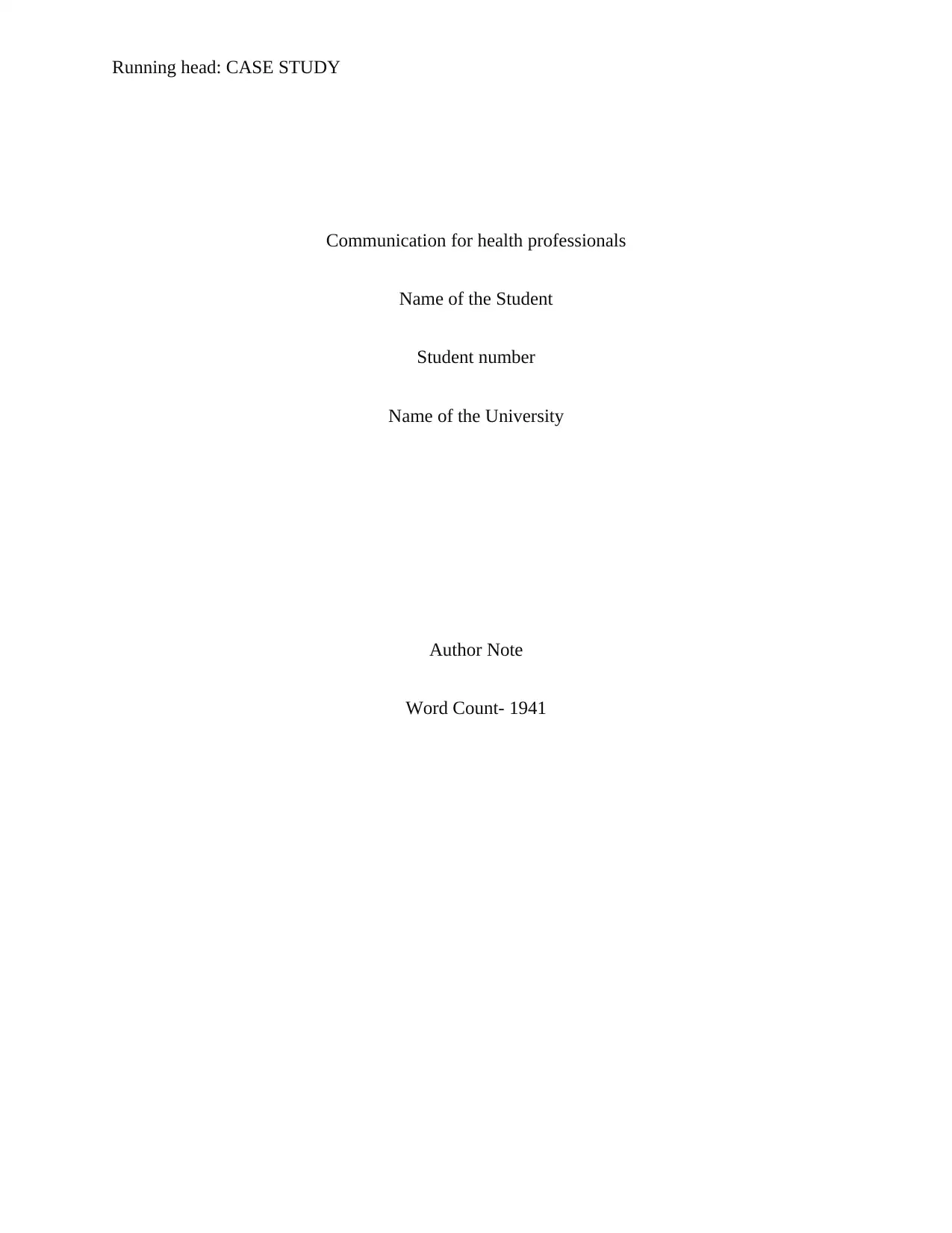
Running head: CASE STUDY
Communication for health professionals
Name of the Student
Student number
Name of the University
Author Note
Word Count- 1941
Communication for health professionals
Name of the Student
Student number
Name of the University
Author Note
Word Count- 1941
Paraphrase This Document
Need a fresh take? Get an instant paraphrase of this document with our AI Paraphraser
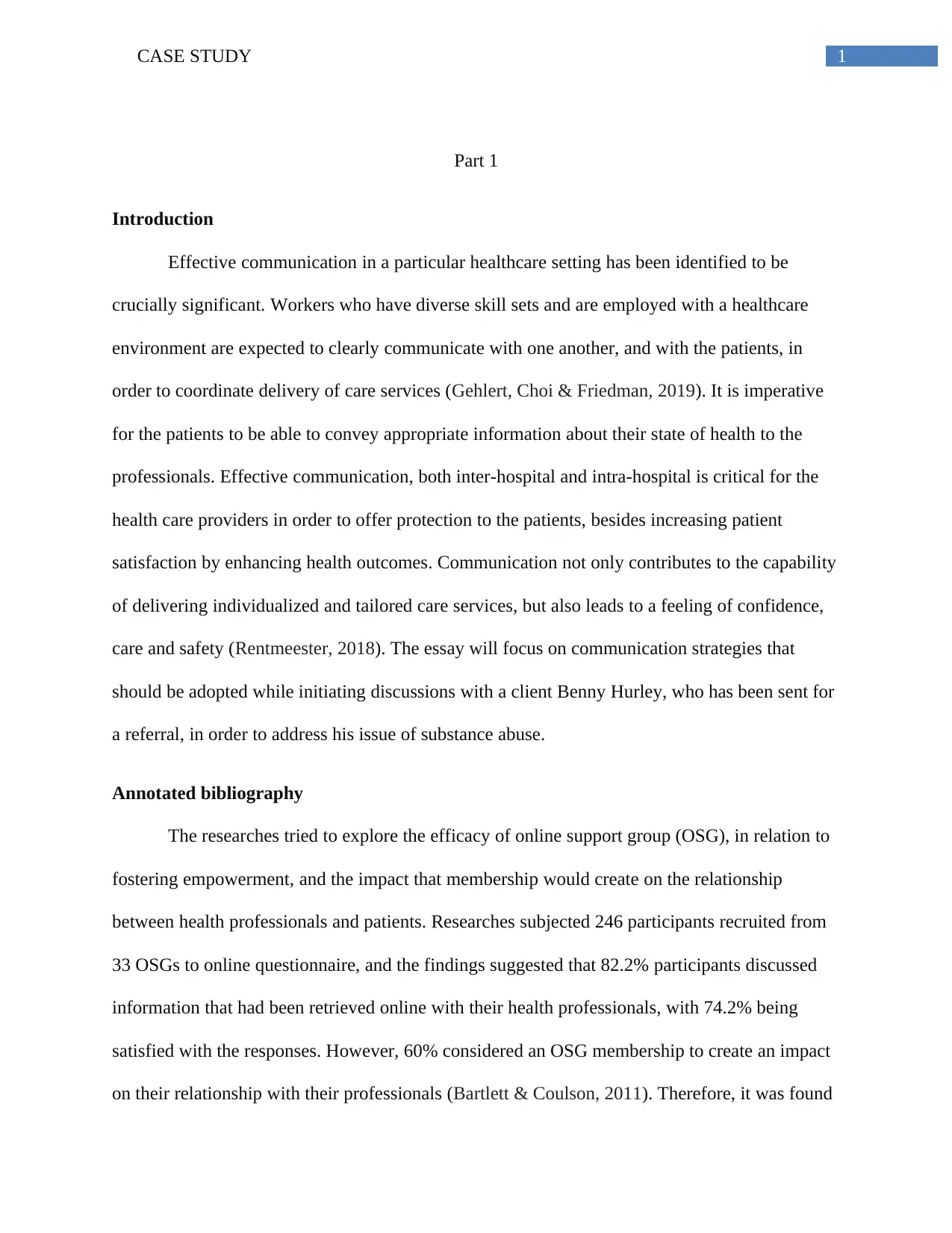
1CASE STUDY
Part 1
Introduction
Effective communication in a particular healthcare setting has been identified to be
crucially significant. Workers who have diverse skill sets and are employed with a healthcare
environment are expected to clearly communicate with one another, and with the patients, in
order to coordinate delivery of care services (Gehlert, Choi & Friedman, 2019). It is imperative
for the patients to be able to convey appropriate information about their state of health to the
professionals. Effective communication, both inter-hospital and intra-hospital is critical for the
health care providers in order to offer protection to the patients, besides increasing patient
satisfaction by enhancing health outcomes. Communication not only contributes to the capability
of delivering individualized and tailored care services, but also leads to a feeling of confidence,
care and safety (Rentmeester, 2018). The essay will focus on communication strategies that
should be adopted while initiating discussions with a client Benny Hurley, who has been sent for
a referral, in order to address his issue of substance abuse.
Annotated bibliography
The researches tried to explore the efficacy of online support group (OSG), in relation to
fostering empowerment, and the impact that membership would create on the relationship
between health professionals and patients. Researches subjected 246 participants recruited from
33 OSGs to online questionnaire, and the findings suggested that 82.2% participants discussed
information that had been retrieved online with their health professionals, with 74.2% being
satisfied with the responses. However, 60% considered an OSG membership to create an impact
on their relationship with their professionals (Bartlett & Coulson, 2011). Therefore, it was found
Part 1
Introduction
Effective communication in a particular healthcare setting has been identified to be
crucially significant. Workers who have diverse skill sets and are employed with a healthcare
environment are expected to clearly communicate with one another, and with the patients, in
order to coordinate delivery of care services (Gehlert, Choi & Friedman, 2019). It is imperative
for the patients to be able to convey appropriate information about their state of health to the
professionals. Effective communication, both inter-hospital and intra-hospital is critical for the
health care providers in order to offer protection to the patients, besides increasing patient
satisfaction by enhancing health outcomes. Communication not only contributes to the capability
of delivering individualized and tailored care services, but also leads to a feeling of confidence,
care and safety (Rentmeester, 2018). The essay will focus on communication strategies that
should be adopted while initiating discussions with a client Benny Hurley, who has been sent for
a referral, in order to address his issue of substance abuse.
Annotated bibliography
The researches tried to explore the efficacy of online support group (OSG), in relation to
fostering empowerment, and the impact that membership would create on the relationship
between health professionals and patients. Researches subjected 246 participants recruited from
33 OSGs to online questionnaire, and the findings suggested that 82.2% participants discussed
information that had been retrieved online with their health professionals, with 74.2% being
satisfied with the responses. However, 60% considered an OSG membership to create an impact
on their relationship with their professionals (Bartlett & Coulson, 2011). Therefore, it was found
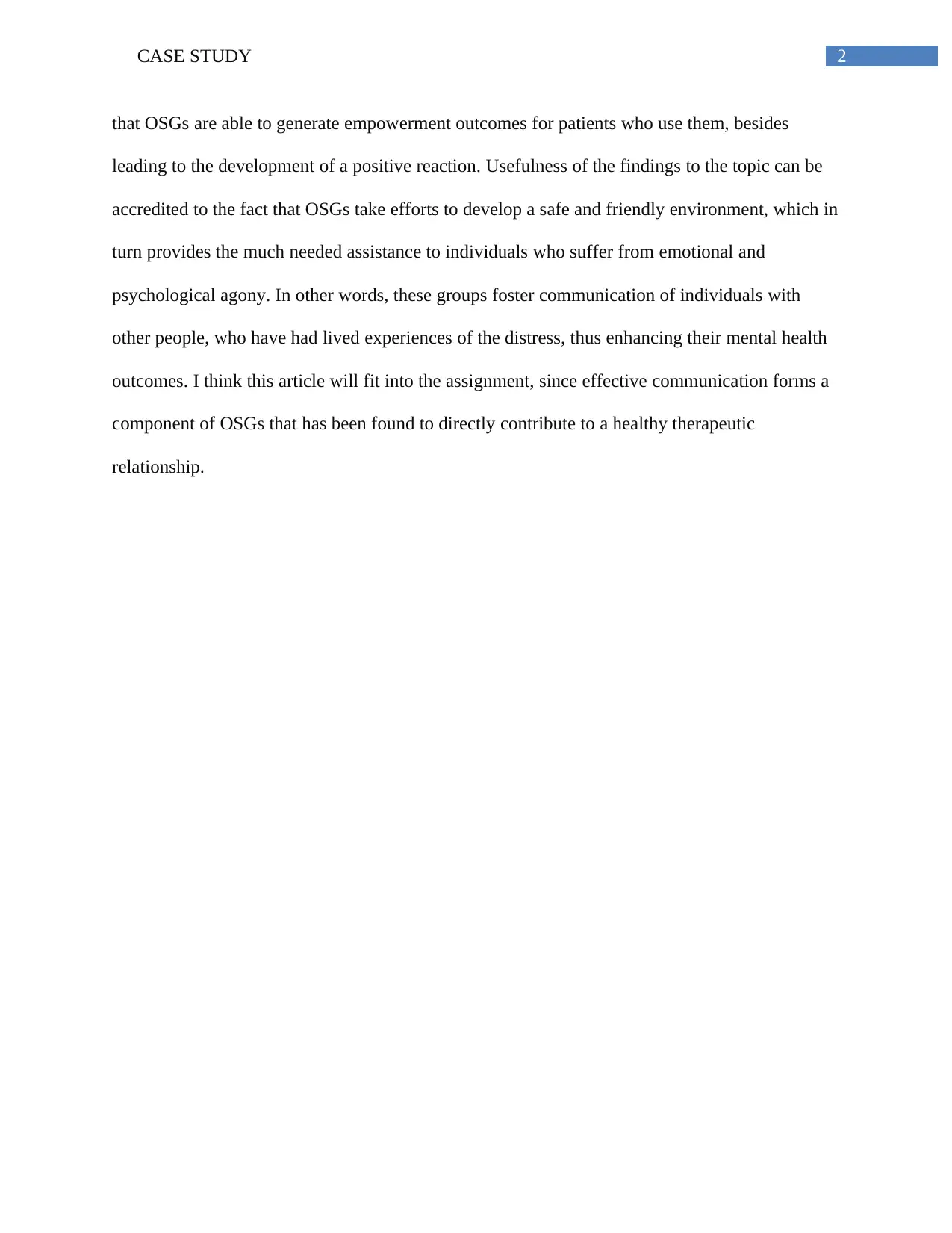
2CASE STUDY
that OSGs are able to generate empowerment outcomes for patients who use them, besides
leading to the development of a positive reaction. Usefulness of the findings to the topic can be
accredited to the fact that OSGs take efforts to develop a safe and friendly environment, which in
turn provides the much needed assistance to individuals who suffer from emotional and
psychological agony. In other words, these groups foster communication of individuals with
other people, who have had lived experiences of the distress, thus enhancing their mental health
outcomes. I think this article will fit into the assignment, since effective communication forms a
component of OSGs that has been found to directly contribute to a healthy therapeutic
relationship.
that OSGs are able to generate empowerment outcomes for patients who use them, besides
leading to the development of a positive reaction. Usefulness of the findings to the topic can be
accredited to the fact that OSGs take efforts to develop a safe and friendly environment, which in
turn provides the much needed assistance to individuals who suffer from emotional and
psychological agony. In other words, these groups foster communication of individuals with
other people, who have had lived experiences of the distress, thus enhancing their mental health
outcomes. I think this article will fit into the assignment, since effective communication forms a
component of OSGs that has been found to directly contribute to a healthy therapeutic
relationship.
⊘ This is a preview!⊘
Do you want full access?
Subscribe today to unlock all pages.

Trusted by 1+ million students worldwide
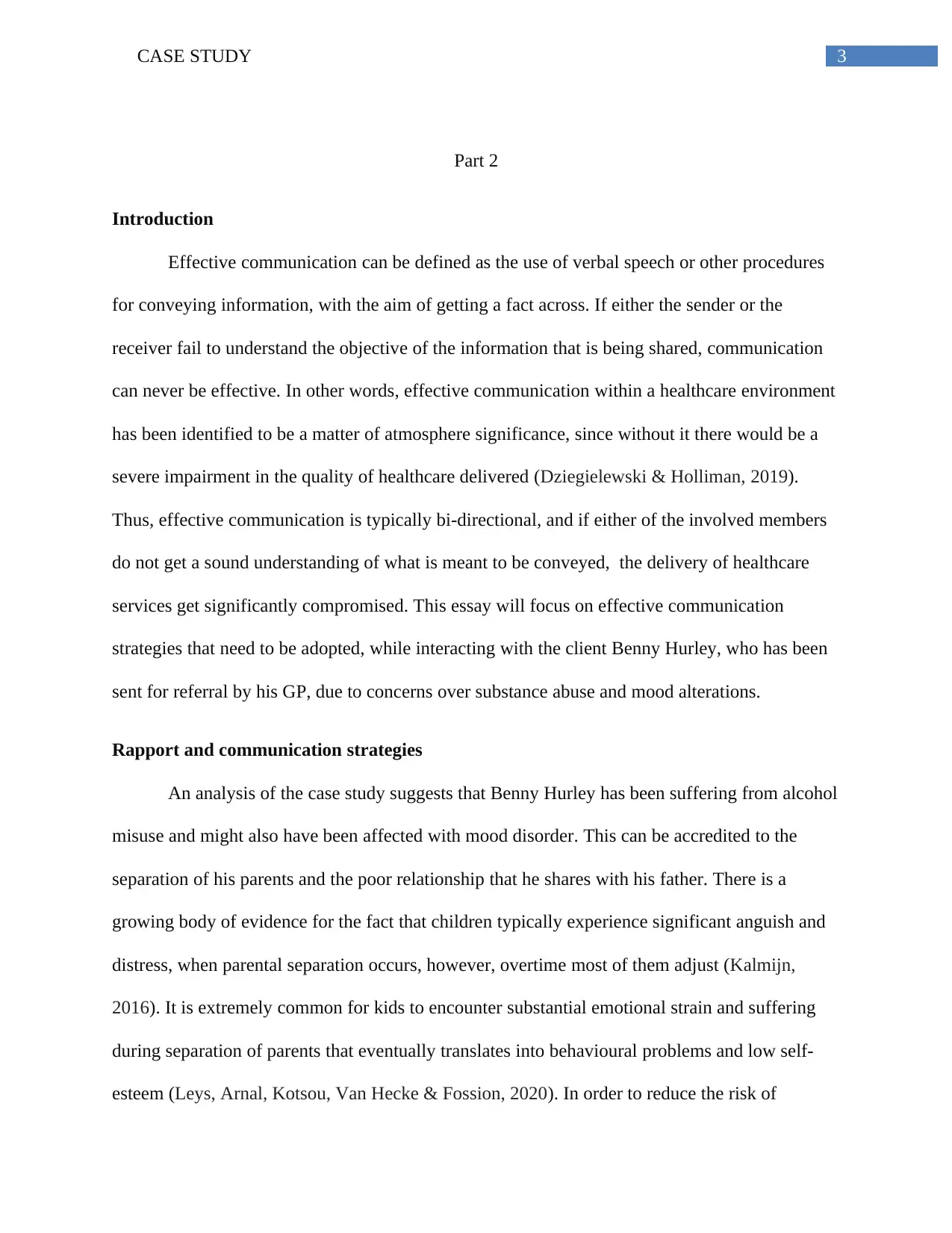
3CASE STUDY
Part 2
Introduction
Effective communication can be defined as the use of verbal speech or other procedures
for conveying information, with the aim of getting a fact across. If either the sender or the
receiver fail to understand the objective of the information that is being shared, communication
can never be effective. In other words, effective communication within a healthcare environment
has been identified to be a matter of atmosphere significance, since without it there would be a
severe impairment in the quality of healthcare delivered (Dziegielewski & Holliman, 2019).
Thus, effective communication is typically bi-directional, and if either of the involved members
do not get a sound understanding of what is meant to be conveyed, the delivery of healthcare
services get significantly compromised. This essay will focus on effective communication
strategies that need to be adopted, while interacting with the client Benny Hurley, who has been
sent for referral by his GP, due to concerns over substance abuse and mood alterations.
Rapport and communication strategies
An analysis of the case study suggests that Benny Hurley has been suffering from alcohol
misuse and might also have been affected with mood disorder. This can be accredited to the
separation of his parents and the poor relationship that he shares with his father. There is a
growing body of evidence for the fact that children typically experience significant anguish and
distress, when parental separation occurs, however, overtime most of them adjust (Kalmijn,
2016). It is extremely common for kids to encounter substantial emotional strain and suffering
during separation of parents that eventually translates into behavioural problems and low self-
esteem (Leys, Arnal, Kotsou, Van Hecke & Fossion, 2020). In order to reduce the risk of
Part 2
Introduction
Effective communication can be defined as the use of verbal speech or other procedures
for conveying information, with the aim of getting a fact across. If either the sender or the
receiver fail to understand the objective of the information that is being shared, communication
can never be effective. In other words, effective communication within a healthcare environment
has been identified to be a matter of atmosphere significance, since without it there would be a
severe impairment in the quality of healthcare delivered (Dziegielewski & Holliman, 2019).
Thus, effective communication is typically bi-directional, and if either of the involved members
do not get a sound understanding of what is meant to be conveyed, the delivery of healthcare
services get significantly compromised. This essay will focus on effective communication
strategies that need to be adopted, while interacting with the client Benny Hurley, who has been
sent for referral by his GP, due to concerns over substance abuse and mood alterations.
Rapport and communication strategies
An analysis of the case study suggests that Benny Hurley has been suffering from alcohol
misuse and might also have been affected with mood disorder. This can be accredited to the
separation of his parents and the poor relationship that he shares with his father. There is a
growing body of evidence for the fact that children typically experience significant anguish and
distress, when parental separation occurs, however, overtime most of them adjust (Kalmijn,
2016). It is extremely common for kids to encounter substantial emotional strain and suffering
during separation of parents that eventually translates into behavioural problems and low self-
esteem (Leys, Arnal, Kotsou, Van Hecke & Fossion, 2020). In order to reduce the risk of
Paraphrase This Document
Need a fresh take? Get an instant paraphrase of this document with our AI Paraphraser
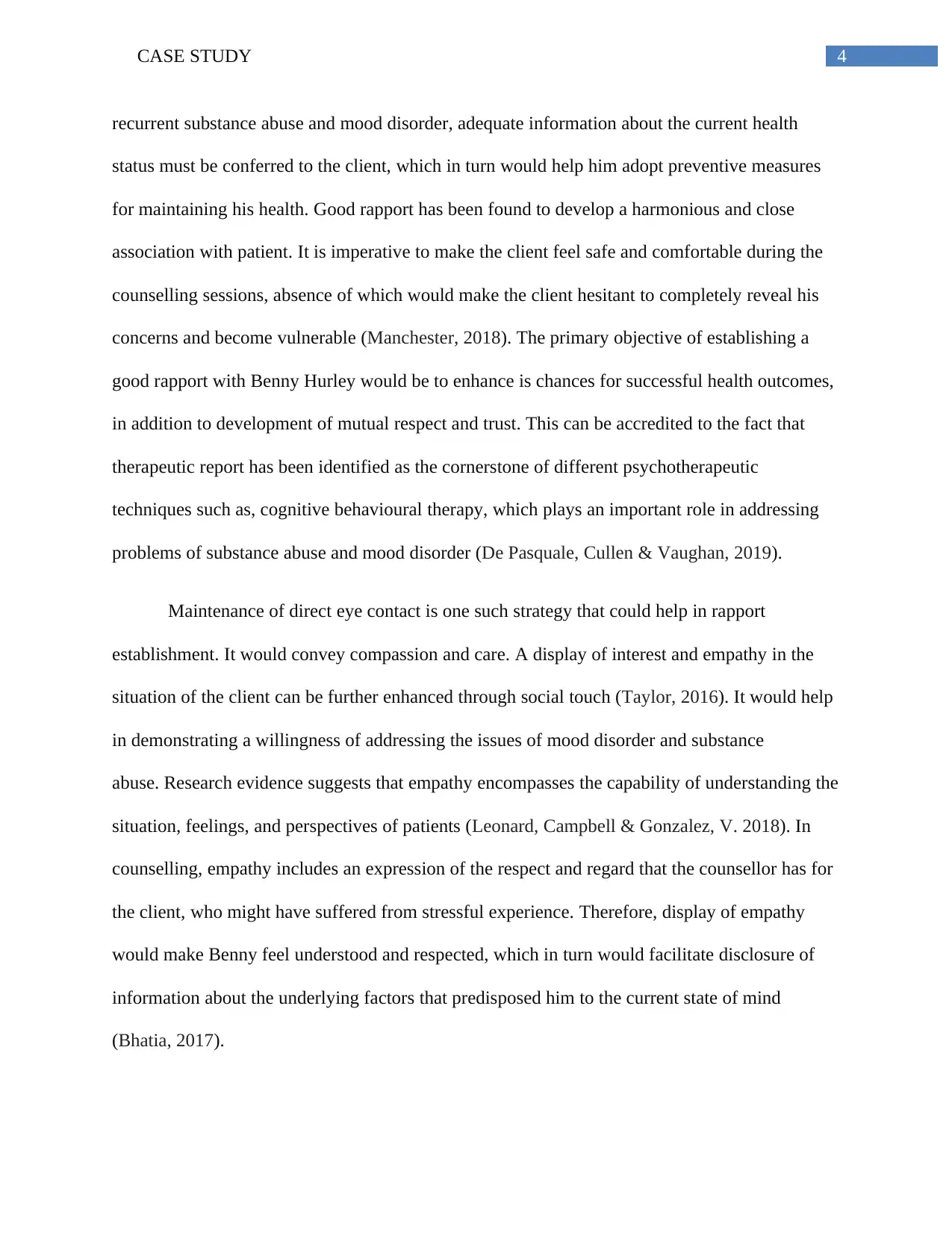
4CASE STUDY
recurrent substance abuse and mood disorder, adequate information about the current health
status must be conferred to the client, which in turn would help him adopt preventive measures
for maintaining his health. Good rapport has been found to develop a harmonious and close
association with patient. It is imperative to make the client feel safe and comfortable during the
counselling sessions, absence of which would make the client hesitant to completely reveal his
concerns and become vulnerable (Manchester, 2018). The primary objective of establishing a
good rapport with Benny Hurley would be to enhance is chances for successful health outcomes,
in addition to development of mutual respect and trust. This can be accredited to the fact that
therapeutic report has been identified as the cornerstone of different psychotherapeutic
techniques such as, cognitive behavioural therapy, which plays an important role in addressing
problems of substance abuse and mood disorder (De Pasquale, Cullen & Vaughan, 2019).
Maintenance of direct eye contact is one such strategy that could help in rapport
establishment. It would convey compassion and care. A display of interest and empathy in the
situation of the client can be further enhanced through social touch (Taylor, 2016). It would help
in demonstrating a willingness of addressing the issues of mood disorder and substance
abuse. Research evidence suggests that empathy encompasses the capability of understanding the
situation, feelings, and perspectives of patients (Leonard, Campbell & Gonzalez, V. 2018). In
counselling, empathy includes an expression of the respect and regard that the counsellor has for
the client, who might have suffered from stressful experience. Therefore, display of empathy
would make Benny feel understood and respected, which in turn would facilitate disclosure of
information about the underlying factors that predisposed him to the current state of mind
(Bhatia, 2017).
recurrent substance abuse and mood disorder, adequate information about the current health
status must be conferred to the client, which in turn would help him adopt preventive measures
for maintaining his health. Good rapport has been found to develop a harmonious and close
association with patient. It is imperative to make the client feel safe and comfortable during the
counselling sessions, absence of which would make the client hesitant to completely reveal his
concerns and become vulnerable (Manchester, 2018). The primary objective of establishing a
good rapport with Benny Hurley would be to enhance is chances for successful health outcomes,
in addition to development of mutual respect and trust. This can be accredited to the fact that
therapeutic report has been identified as the cornerstone of different psychotherapeutic
techniques such as, cognitive behavioural therapy, which plays an important role in addressing
problems of substance abuse and mood disorder (De Pasquale, Cullen & Vaughan, 2019).
Maintenance of direct eye contact is one such strategy that could help in rapport
establishment. It would convey compassion and care. A display of interest and empathy in the
situation of the client can be further enhanced through social touch (Taylor, 2016). It would help
in demonstrating a willingness of addressing the issues of mood disorder and substance
abuse. Research evidence suggests that empathy encompasses the capability of understanding the
situation, feelings, and perspectives of patients (Leonard, Campbell & Gonzalez, V. 2018). In
counselling, empathy includes an expression of the respect and regard that the counsellor has for
the client, who might have suffered from stressful experience. Therefore, display of empathy
would make Benny feel understood and respected, which in turn would facilitate disclosure of
information about the underlying factors that predisposed him to the current state of mind
(Bhatia, 2017).
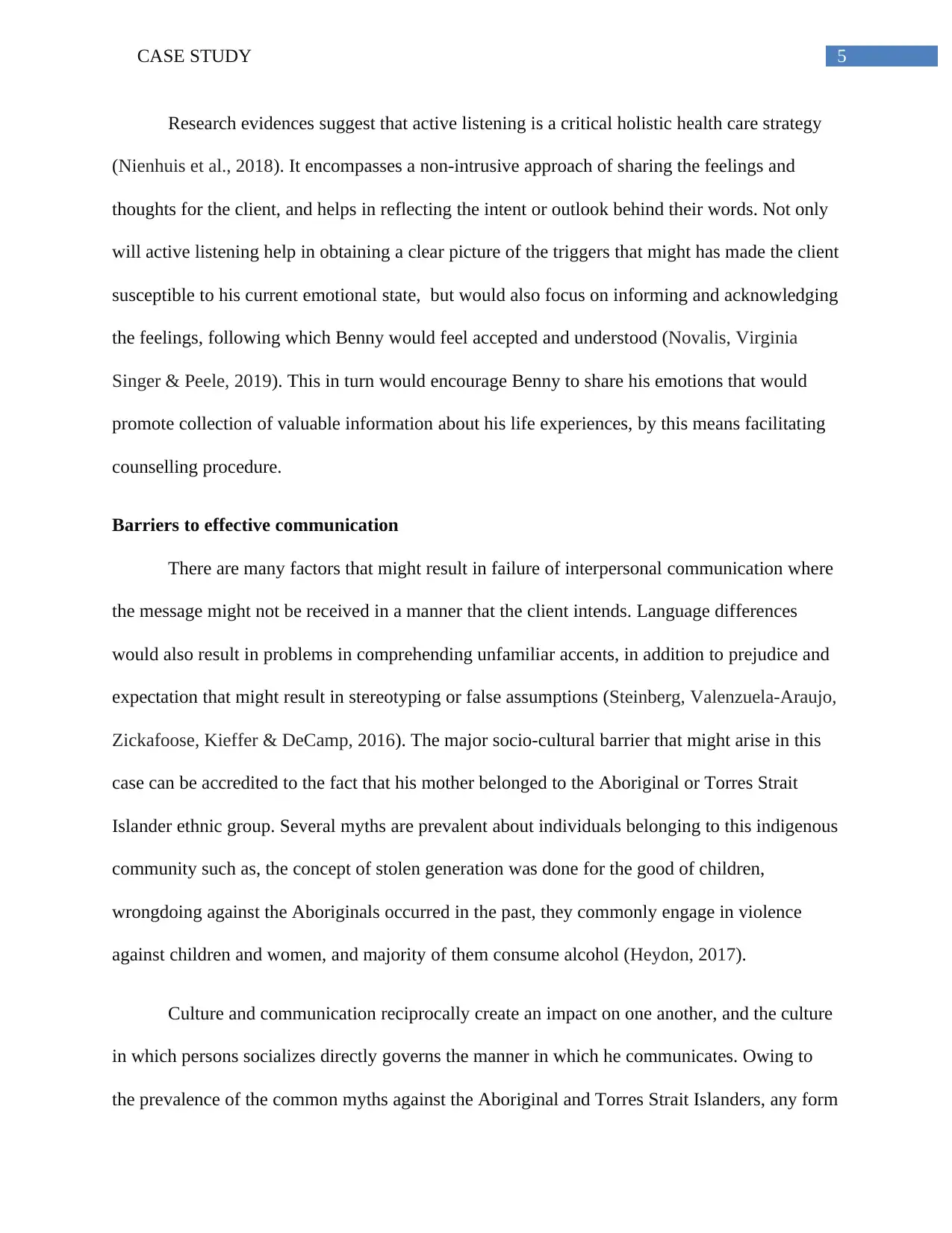
5CASE STUDY
Research evidences suggest that active listening is a critical holistic health care strategy
(Nienhuis et al., 2018). It encompasses a non-intrusive approach of sharing the feelings and
thoughts for the client, and helps in reflecting the intent or outlook behind their words. Not only
will active listening help in obtaining a clear picture of the triggers that might has made the client
susceptible to his current emotional state, but would also focus on informing and acknowledging
the feelings, following which Benny would feel accepted and understood (Novalis, Virginia
Singer & Peele, 2019). This in turn would encourage Benny to share his emotions that would
promote collection of valuable information about his life experiences, by this means facilitating
counselling procedure.
Barriers to effective communication
There are many factors that might result in failure of interpersonal communication where
the message might not be received in a manner that the client intends. Language differences
would also result in problems in comprehending unfamiliar accents, in addition to prejudice and
expectation that might result in stereotyping or false assumptions (Steinberg, Valenzuela-Araujo,
Zickafoose, Kieffer & DeCamp, 2016). The major socio-cultural barrier that might arise in this
case can be accredited to the fact that his mother belonged to the Aboriginal or Torres Strait
Islander ethnic group. Several myths are prevalent about individuals belonging to this indigenous
community such as, the concept of stolen generation was done for the good of children,
wrongdoing against the Aboriginals occurred in the past, they commonly engage in violence
against children and women, and majority of them consume alcohol (Heydon, 2017).
Culture and communication reciprocally create an impact on one another, and the culture
in which persons socializes directly governs the manner in which he communicates. Owing to
the prevalence of the common myths against the Aboriginal and Torres Strait Islanders, any form
Research evidences suggest that active listening is a critical holistic health care strategy
(Nienhuis et al., 2018). It encompasses a non-intrusive approach of sharing the feelings and
thoughts for the client, and helps in reflecting the intent or outlook behind their words. Not only
will active listening help in obtaining a clear picture of the triggers that might has made the client
susceptible to his current emotional state, but would also focus on informing and acknowledging
the feelings, following which Benny would feel accepted and understood (Novalis, Virginia
Singer & Peele, 2019). This in turn would encourage Benny to share his emotions that would
promote collection of valuable information about his life experiences, by this means facilitating
counselling procedure.
Barriers to effective communication
There are many factors that might result in failure of interpersonal communication where
the message might not be received in a manner that the client intends. Language differences
would also result in problems in comprehending unfamiliar accents, in addition to prejudice and
expectation that might result in stereotyping or false assumptions (Steinberg, Valenzuela-Araujo,
Zickafoose, Kieffer & DeCamp, 2016). The major socio-cultural barrier that might arise in this
case can be accredited to the fact that his mother belonged to the Aboriginal or Torres Strait
Islander ethnic group. Several myths are prevalent about individuals belonging to this indigenous
community such as, the concept of stolen generation was done for the good of children,
wrongdoing against the Aboriginals occurred in the past, they commonly engage in violence
against children and women, and majority of them consume alcohol (Heydon, 2017).
Culture and communication reciprocally create an impact on one another, and the culture
in which persons socializes directly governs the manner in which he communicates. Owing to
the prevalence of the common myths against the Aboriginal and Torres Strait Islanders, any form
⊘ This is a preview!⊘
Do you want full access?
Subscribe today to unlock all pages.

Trusted by 1+ million students worldwide
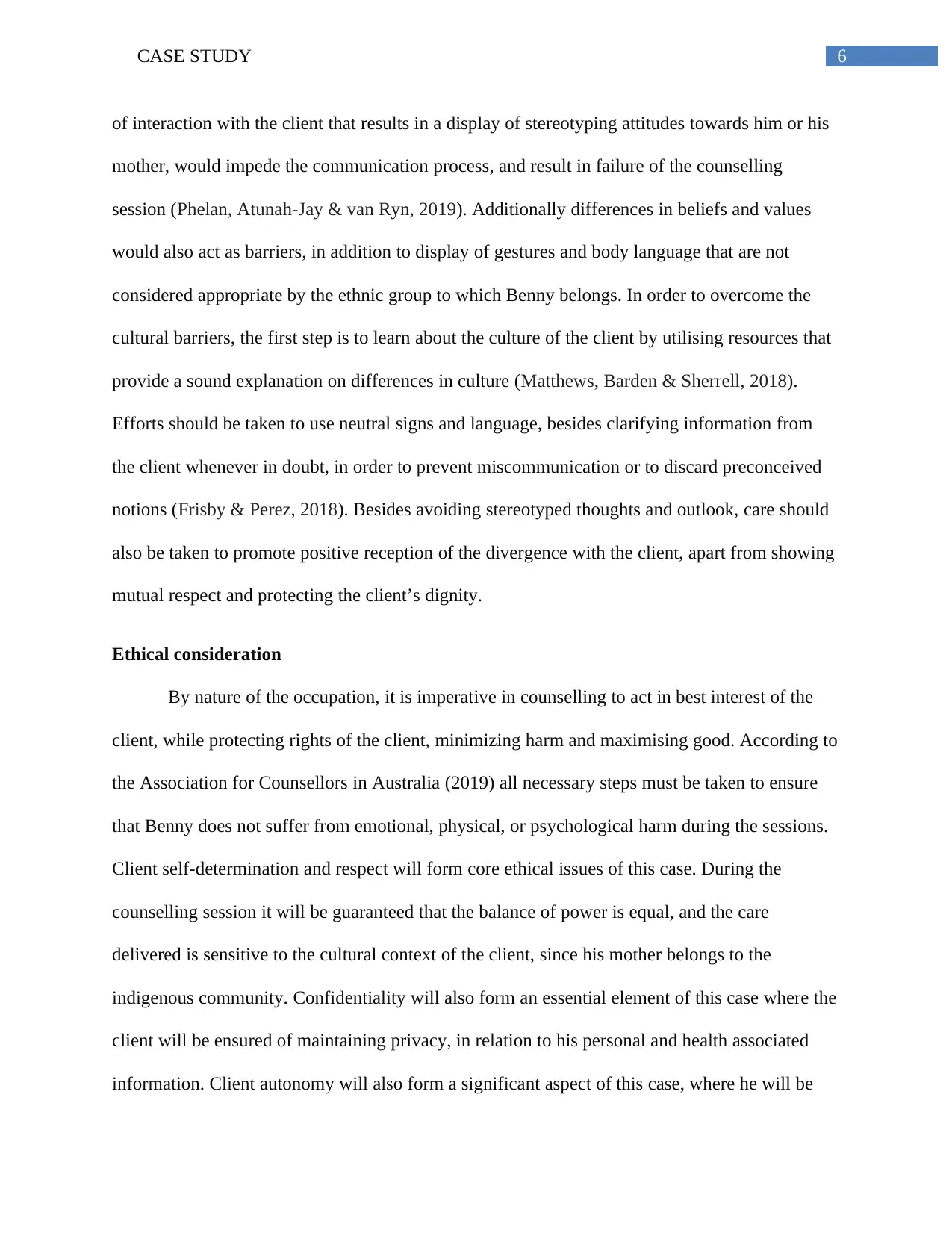
6CASE STUDY
of interaction with the client that results in a display of stereotyping attitudes towards him or his
mother, would impede the communication process, and result in failure of the counselling
session (Phelan, Atunah-Jay & van Ryn, 2019). Additionally differences in beliefs and values
would also act as barriers, in addition to display of gestures and body language that are not
considered appropriate by the ethnic group to which Benny belongs. In order to overcome the
cultural barriers, the first step is to learn about the culture of the client by utilising resources that
provide a sound explanation on differences in culture (Matthews, Barden & Sherrell, 2018).
Efforts should be taken to use neutral signs and language, besides clarifying information from
the client whenever in doubt, in order to prevent miscommunication or to discard preconceived
notions (Frisby & Perez, 2018). Besides avoiding stereotyped thoughts and outlook, care should
also be taken to promote positive reception of the divergence with the client, apart from showing
mutual respect and protecting the client’s dignity.
Ethical consideration
By nature of the occupation, it is imperative in counselling to act in best interest of the
client, while protecting rights of the client, minimizing harm and maximising good. According to
the Association for Counsellors in Australia (2019) all necessary steps must be taken to ensure
that Benny does not suffer from emotional, physical, or psychological harm during the sessions.
Client self-determination and respect will form core ethical issues of this case. During the
counselling session it will be guaranteed that the balance of power is equal, and the care
delivered is sensitive to the cultural context of the client, since his mother belongs to the
indigenous community. Confidentiality will also form an essential element of this case where the
client will be ensured of maintaining privacy, in relation to his personal and health associated
information. Client autonomy will also form a significant aspect of this case, where he will be
of interaction with the client that results in a display of stereotyping attitudes towards him or his
mother, would impede the communication process, and result in failure of the counselling
session (Phelan, Atunah-Jay & van Ryn, 2019). Additionally differences in beliefs and values
would also act as barriers, in addition to display of gestures and body language that are not
considered appropriate by the ethnic group to which Benny belongs. In order to overcome the
cultural barriers, the first step is to learn about the culture of the client by utilising resources that
provide a sound explanation on differences in culture (Matthews, Barden & Sherrell, 2018).
Efforts should be taken to use neutral signs and language, besides clarifying information from
the client whenever in doubt, in order to prevent miscommunication or to discard preconceived
notions (Frisby & Perez, 2018). Besides avoiding stereotyped thoughts and outlook, care should
also be taken to promote positive reception of the divergence with the client, apart from showing
mutual respect and protecting the client’s dignity.
Ethical consideration
By nature of the occupation, it is imperative in counselling to act in best interest of the
client, while protecting rights of the client, minimizing harm and maximising good. According to
the Association for Counsellors in Australia (2019) all necessary steps must be taken to ensure
that Benny does not suffer from emotional, physical, or psychological harm during the sessions.
Client self-determination and respect will form core ethical issues of this case. During the
counselling session it will be guaranteed that the balance of power is equal, and the care
delivered is sensitive to the cultural context of the client, since his mother belongs to the
indigenous community. Confidentiality will also form an essential element of this case where the
client will be ensured of maintaining privacy, in relation to his personal and health associated
information. Client autonomy will also form a significant aspect of this case, where he will be
Paraphrase This Document
Need a fresh take? Get an instant paraphrase of this document with our AI Paraphraser
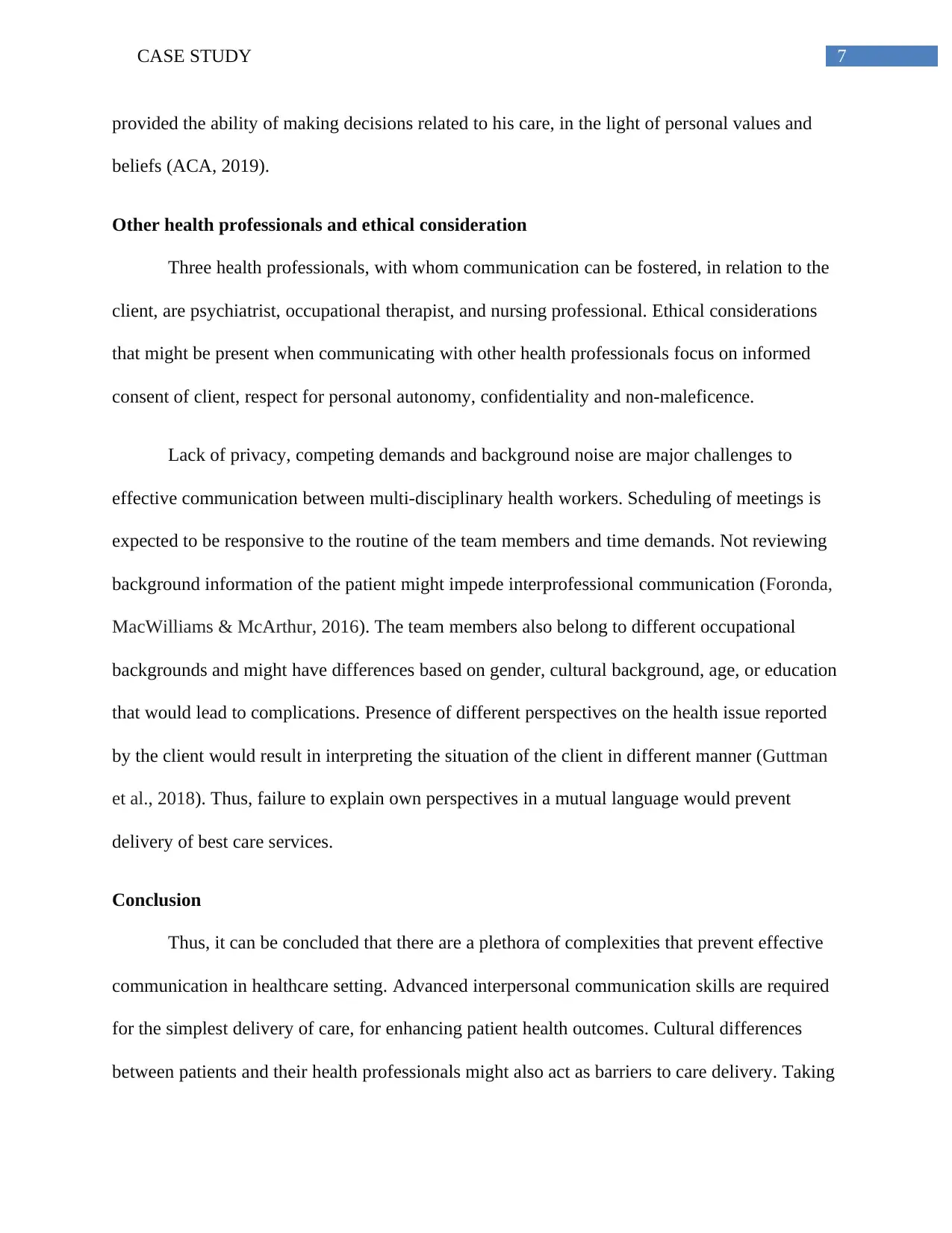
7CASE STUDY
provided the ability of making decisions related to his care, in the light of personal values and
beliefs (ACA, 2019).
Other health professionals and ethical consideration
Three health professionals, with whom communication can be fostered, in relation to the
client, are psychiatrist, occupational therapist, and nursing professional. Ethical considerations
that might be present when communicating with other health professionals focus on informed
consent of client, respect for personal autonomy, confidentiality and non-maleficence.
Lack of privacy, competing demands and background noise are major challenges to
effective communication between multi-disciplinary health workers. Scheduling of meetings is
expected to be responsive to the routine of the team members and time demands. Not reviewing
background information of the patient might impede interprofessional communication (Foronda,
MacWilliams & McArthur, 2016). The team members also belong to different occupational
backgrounds and might have differences based on gender, cultural background, age, or education
that would lead to complications. Presence of different perspectives on the health issue reported
by the client would result in interpreting the situation of the client in different manner (Guttman
et al., 2018). Thus, failure to explain own perspectives in a mutual language would prevent
delivery of best care services.
Conclusion
Thus, it can be concluded that there are a plethora of complexities that prevent effective
communication in healthcare setting. Advanced interpersonal communication skills are required
for the simplest delivery of care, for enhancing patient health outcomes. Cultural differences
between patients and their health professionals might also act as barriers to care delivery. Taking
provided the ability of making decisions related to his care, in the light of personal values and
beliefs (ACA, 2019).
Other health professionals and ethical consideration
Three health professionals, with whom communication can be fostered, in relation to the
client, are psychiatrist, occupational therapist, and nursing professional. Ethical considerations
that might be present when communicating with other health professionals focus on informed
consent of client, respect for personal autonomy, confidentiality and non-maleficence.
Lack of privacy, competing demands and background noise are major challenges to
effective communication between multi-disciplinary health workers. Scheduling of meetings is
expected to be responsive to the routine of the team members and time demands. Not reviewing
background information of the patient might impede interprofessional communication (Foronda,
MacWilliams & McArthur, 2016). The team members also belong to different occupational
backgrounds and might have differences based on gender, cultural background, age, or education
that would lead to complications. Presence of different perspectives on the health issue reported
by the client would result in interpreting the situation of the client in different manner (Guttman
et al., 2018). Thus, failure to explain own perspectives in a mutual language would prevent
delivery of best care services.
Conclusion
Thus, it can be concluded that there are a plethora of complexities that prevent effective
communication in healthcare setting. Advanced interpersonal communication skills are required
for the simplest delivery of care, for enhancing patient health outcomes. Cultural differences
between patients and their health professionals might also act as barriers to care delivery. Taking
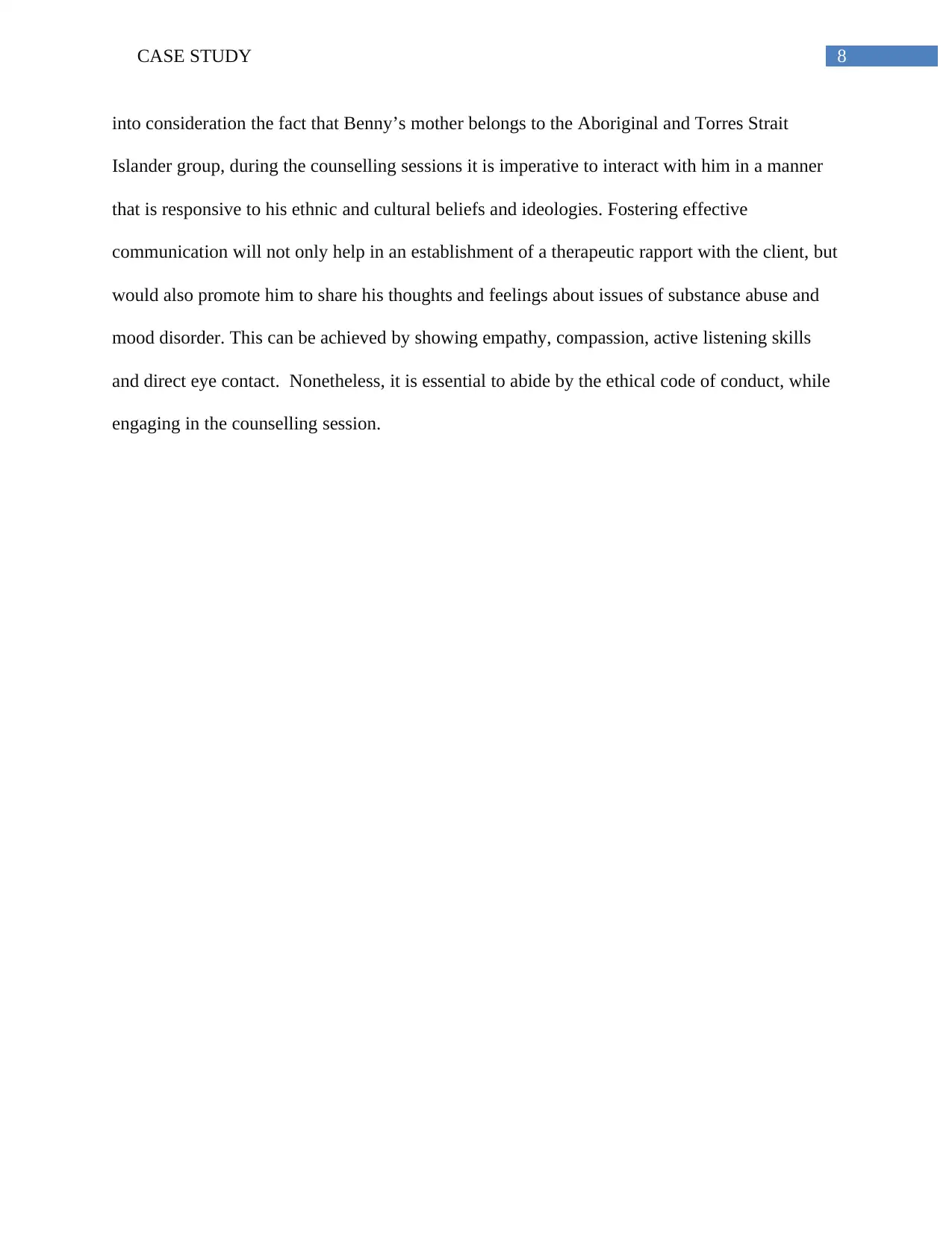
8CASE STUDY
into consideration the fact that Benny’s mother belongs to the Aboriginal and Torres Strait
Islander group, during the counselling sessions it is imperative to interact with him in a manner
that is responsive to his ethnic and cultural beliefs and ideologies. Fostering effective
communication will not only help in an establishment of a therapeutic rapport with the client, but
would also promote him to share his thoughts and feelings about issues of substance abuse and
mood disorder. This can be achieved by showing empathy, compassion, active listening skills
and direct eye contact. Nonetheless, it is essential to abide by the ethical code of conduct, while
engaging in the counselling session.
into consideration the fact that Benny’s mother belongs to the Aboriginal and Torres Strait
Islander group, during the counselling sessions it is imperative to interact with him in a manner
that is responsive to his ethnic and cultural beliefs and ideologies. Fostering effective
communication will not only help in an establishment of a therapeutic rapport with the client, but
would also promote him to share his thoughts and feelings about issues of substance abuse and
mood disorder. This can be achieved by showing empathy, compassion, active listening skills
and direct eye contact. Nonetheless, it is essential to abide by the ethical code of conduct, while
engaging in the counselling session.
⊘ This is a preview!⊘
Do you want full access?
Subscribe today to unlock all pages.

Trusted by 1+ million students worldwide
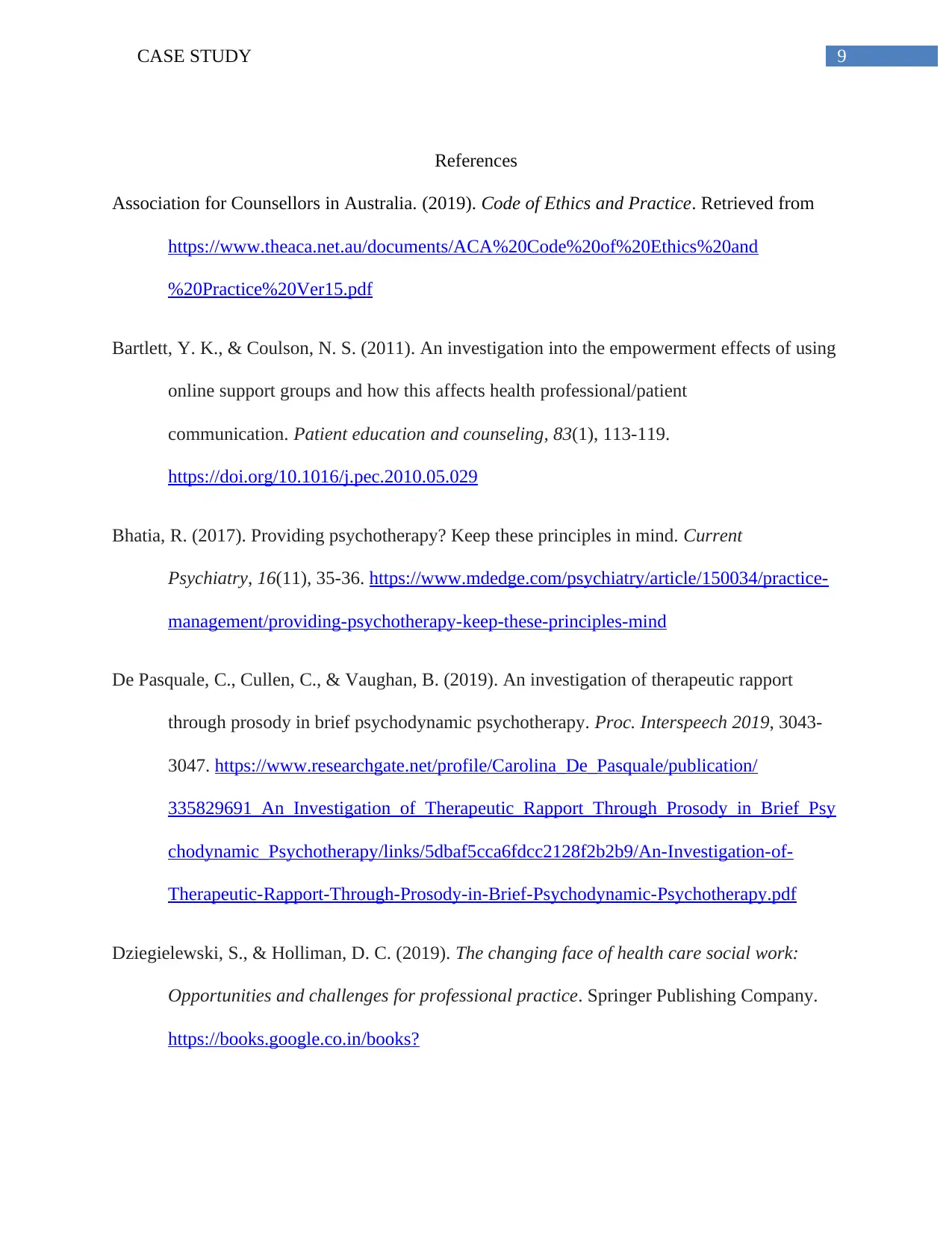
9CASE STUDY
References
Association for Counsellors in Australia. (2019). Code of Ethics and Practice. Retrieved from
https://www.theaca.net.au/documents/ACA%20Code%20of%20Ethics%20and
%20Practice%20Ver15.pdf
Bartlett, Y. K., & Coulson, N. S. (2011). An investigation into the empowerment effects of using
online support groups and how this affects health professional/patient
communication. Patient education and counseling, 83(1), 113-119.
https://doi.org/10.1016/j.pec.2010.05.029
Bhatia, R. (2017). Providing psychotherapy? Keep these principles in mind. Current
Psychiatry, 16(11), 35-36. https://www.mdedge.com/psychiatry/article/150034/practice-
management/providing-psychotherapy-keep-these-principles-mind
De Pasquale, C., Cullen, C., & Vaughan, B. (2019). An investigation of therapeutic rapport
through prosody in brief psychodynamic psychotherapy. Proc. Interspeech 2019, 3043-
3047. https://www.researchgate.net/profile/Carolina_De_Pasquale/publication/
335829691_An_Investigation_of_Therapeutic_Rapport_Through_Prosody_in_Brief_Psy
chodynamic_Psychotherapy/links/5dbaf5cca6fdcc2128f2b2b9/An-Investigation-of-
Therapeutic-Rapport-Through-Prosody-in-Brief-Psychodynamic-Psychotherapy.pdf
Dziegielewski, S., & Holliman, D. C. (2019). The changing face of health care social work:
Opportunities and challenges for professional practice. Springer Publishing Company.
https://books.google.co.in/books?
References
Association for Counsellors in Australia. (2019). Code of Ethics and Practice. Retrieved from
https://www.theaca.net.au/documents/ACA%20Code%20of%20Ethics%20and
%20Practice%20Ver15.pdf
Bartlett, Y. K., & Coulson, N. S. (2011). An investigation into the empowerment effects of using
online support groups and how this affects health professional/patient
communication. Patient education and counseling, 83(1), 113-119.
https://doi.org/10.1016/j.pec.2010.05.029
Bhatia, R. (2017). Providing psychotherapy? Keep these principles in mind. Current
Psychiatry, 16(11), 35-36. https://www.mdedge.com/psychiatry/article/150034/practice-
management/providing-psychotherapy-keep-these-principles-mind
De Pasquale, C., Cullen, C., & Vaughan, B. (2019). An investigation of therapeutic rapport
through prosody in brief psychodynamic psychotherapy. Proc. Interspeech 2019, 3043-
3047. https://www.researchgate.net/profile/Carolina_De_Pasquale/publication/
335829691_An_Investigation_of_Therapeutic_Rapport_Through_Prosody_in_Brief_Psy
chodynamic_Psychotherapy/links/5dbaf5cca6fdcc2128f2b2b9/An-Investigation-of-
Therapeutic-Rapport-Through-Prosody-in-Brief-Psychodynamic-Psychotherapy.pdf
Dziegielewski, S., & Holliman, D. C. (2019). The changing face of health care social work:
Opportunities and challenges for professional practice. Springer Publishing Company.
https://books.google.co.in/books?
Paraphrase This Document
Need a fresh take? Get an instant paraphrase of this document with our AI Paraphraser
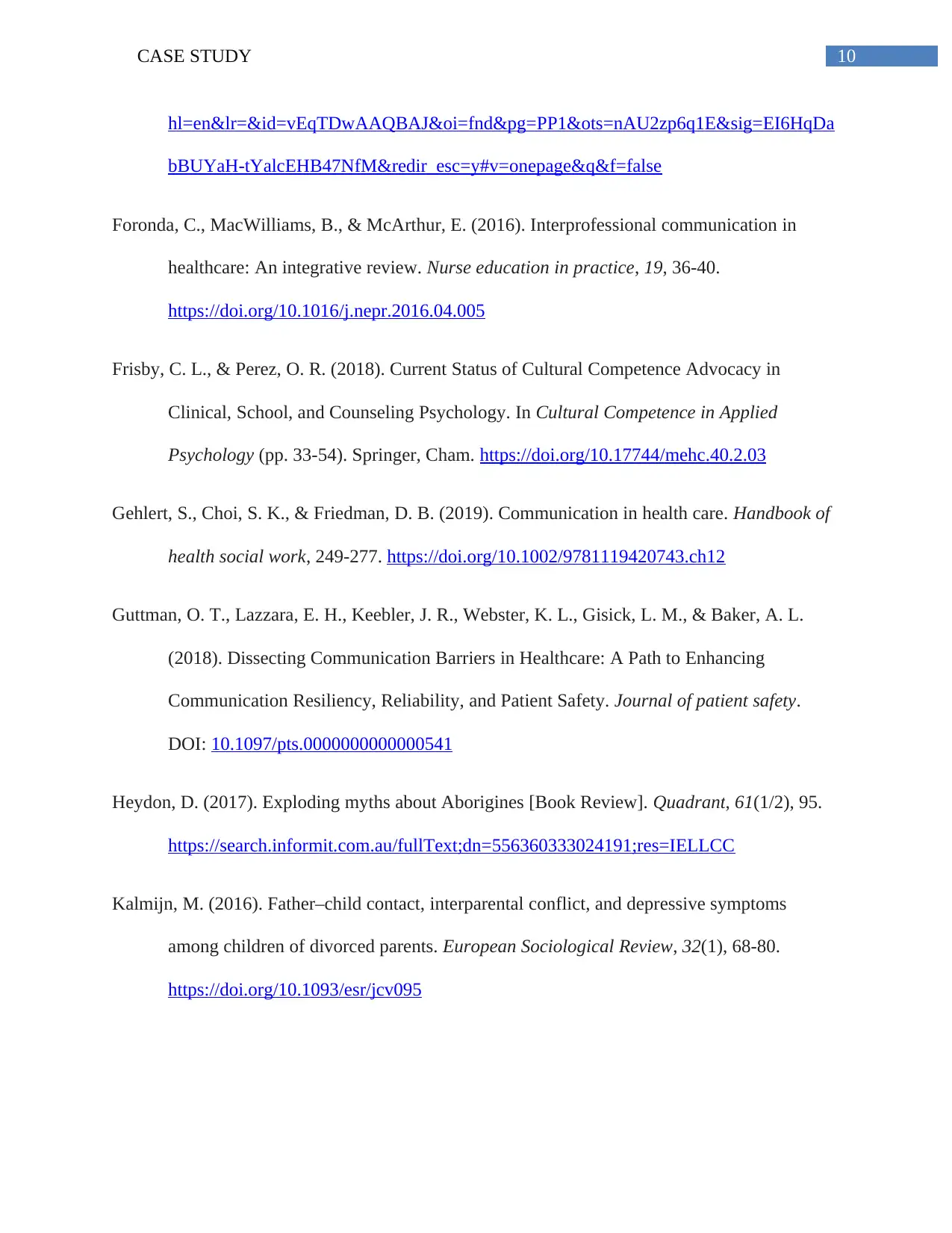
10CASE STUDY
hl=en&lr=&id=vEqTDwAAQBAJ&oi=fnd&pg=PP1&ots=nAU2zp6q1E&sig=EI6HqDa
bBUYaH-tYalcEHB47NfM&redir_esc=y#v=onepage&q&f=false
Foronda, C., MacWilliams, B., & McArthur, E. (2016). Interprofessional communication in
healthcare: An integrative review. Nurse education in practice, 19, 36-40.
https://doi.org/10.1016/j.nepr.2016.04.005
Frisby, C. L., & Perez, O. R. (2018). Current Status of Cultural Competence Advocacy in
Clinical, School, and Counseling Psychology. In Cultural Competence in Applied
Psychology (pp. 33-54). Springer, Cham. https://doi.org/10.17744/mehc.40.2.03
Gehlert, S., Choi, S. K., & Friedman, D. B. (2019). Communication in health care. Handbook of
health social work, 249-277. https://doi.org/10.1002/9781119420743.ch12
Guttman, O. T., Lazzara, E. H., Keebler, J. R., Webster, K. L., Gisick, L. M., & Baker, A. L.
(2018). Dissecting Communication Barriers in Healthcare: A Path to Enhancing
Communication Resiliency, Reliability, and Patient Safety. Journal of patient safety.
DOI: 10.1097/pts.0000000000000541
Heydon, D. (2017). Exploding myths about Aborigines [Book Review]. Quadrant, 61(1/2), 95.
https://search.informit.com.au/fullText;dn=556360333024191;res=IELLCC
Kalmijn, M. (2016). Father–child contact, interparental conflict, and depressive symptoms
among children of divorced parents. European Sociological Review, 32(1), 68-80.
https://doi.org/10.1093/esr/jcv095
hl=en&lr=&id=vEqTDwAAQBAJ&oi=fnd&pg=PP1&ots=nAU2zp6q1E&sig=EI6HqDa
bBUYaH-tYalcEHB47NfM&redir_esc=y#v=onepage&q&f=false
Foronda, C., MacWilliams, B., & McArthur, E. (2016). Interprofessional communication in
healthcare: An integrative review. Nurse education in practice, 19, 36-40.
https://doi.org/10.1016/j.nepr.2016.04.005
Frisby, C. L., & Perez, O. R. (2018). Current Status of Cultural Competence Advocacy in
Clinical, School, and Counseling Psychology. In Cultural Competence in Applied
Psychology (pp. 33-54). Springer, Cham. https://doi.org/10.17744/mehc.40.2.03
Gehlert, S., Choi, S. K., & Friedman, D. B. (2019). Communication in health care. Handbook of
health social work, 249-277. https://doi.org/10.1002/9781119420743.ch12
Guttman, O. T., Lazzara, E. H., Keebler, J. R., Webster, K. L., Gisick, L. M., & Baker, A. L.
(2018). Dissecting Communication Barriers in Healthcare: A Path to Enhancing
Communication Resiliency, Reliability, and Patient Safety. Journal of patient safety.
DOI: 10.1097/pts.0000000000000541
Heydon, D. (2017). Exploding myths about Aborigines [Book Review]. Quadrant, 61(1/2), 95.
https://search.informit.com.au/fullText;dn=556360333024191;res=IELLCC
Kalmijn, M. (2016). Father–child contact, interparental conflict, and depressive symptoms
among children of divorced parents. European Sociological Review, 32(1), 68-80.
https://doi.org/10.1093/esr/jcv095
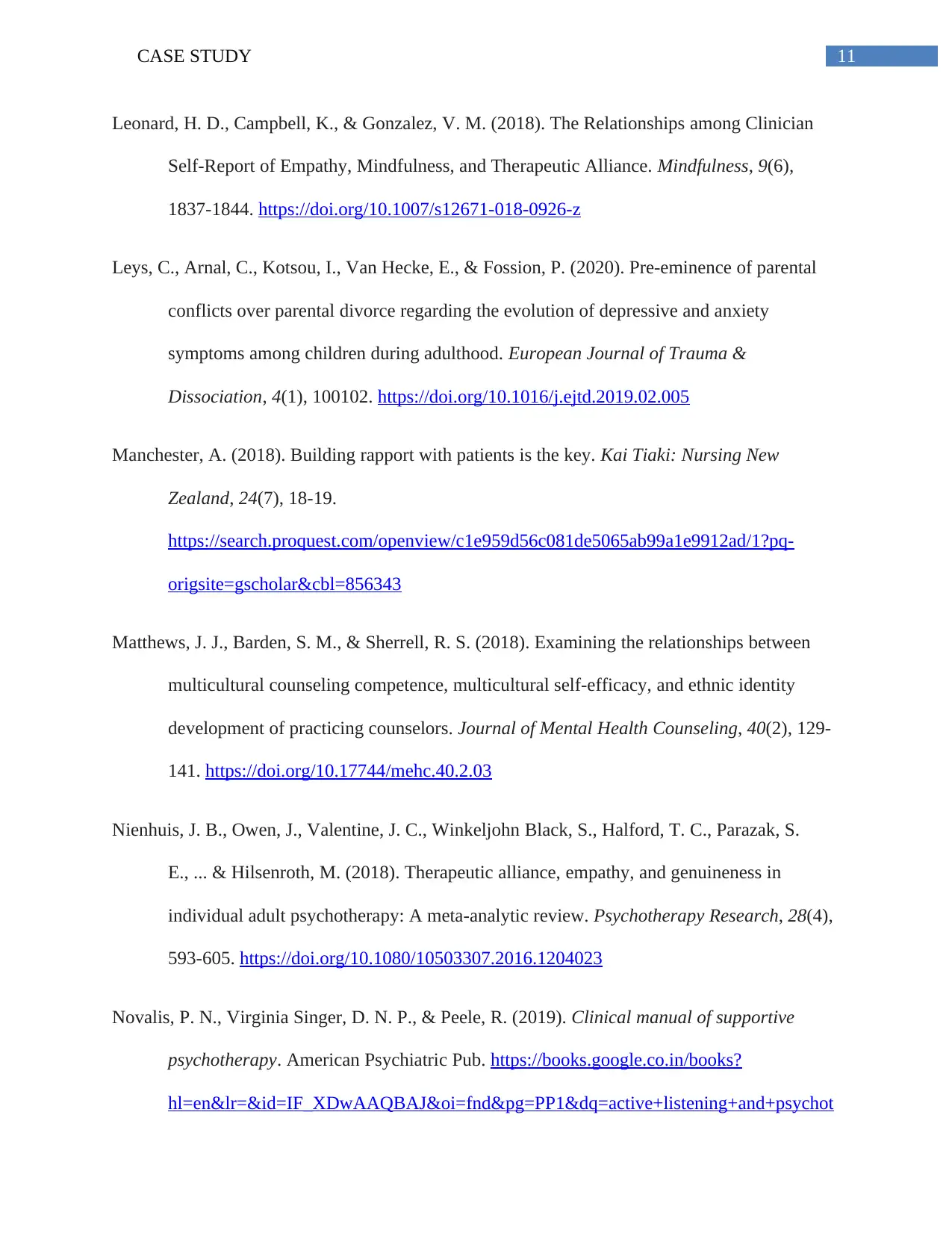
11CASE STUDY
Leonard, H. D., Campbell, K., & Gonzalez, V. M. (2018). The Relationships among Clinician
Self-Report of Empathy, Mindfulness, and Therapeutic Alliance. Mindfulness, 9(6),
1837-1844. https://doi.org/10.1007/s12671-018-0926-z
Leys, C., Arnal, C., Kotsou, I., Van Hecke, E., & Fossion, P. (2020). Pre-eminence of parental
conflicts over parental divorce regarding the evolution of depressive and anxiety
symptoms among children during adulthood. European Journal of Trauma &
Dissociation, 4(1), 100102. https://doi.org/10.1016/j.ejtd.2019.02.005
Manchester, A. (2018). Building rapport with patients is the key. Kai Tiaki: Nursing New
Zealand, 24(7), 18-19.
https://search.proquest.com/openview/c1e959d56c081de5065ab99a1e9912ad/1?pq-
origsite=gscholar&cbl=856343
Matthews, J. J., Barden, S. M., & Sherrell, R. S. (2018). Examining the relationships between
multicultural counseling competence, multicultural self-efficacy, and ethnic identity
development of practicing counselors. Journal of Mental Health Counseling, 40(2), 129-
141. https://doi.org/10.17744/mehc.40.2.03
Nienhuis, J. B., Owen, J., Valentine, J. C., Winkeljohn Black, S., Halford, T. C., Parazak, S.
E., ... & Hilsenroth, M. (2018). Therapeutic alliance, empathy, and genuineness in
individual adult psychotherapy: A meta-analytic review. Psychotherapy Research, 28(4),
593-605. https://doi.org/10.1080/10503307.2016.1204023
Novalis, P. N., Virginia Singer, D. N. P., & Peele, R. (2019). Clinical manual of supportive
psychotherapy. American Psychiatric Pub. https://books.google.co.in/books?
hl=en&lr=&id=IF_XDwAAQBAJ&oi=fnd&pg=PP1&dq=active+listening+and+psychot
Leonard, H. D., Campbell, K., & Gonzalez, V. M. (2018). The Relationships among Clinician
Self-Report of Empathy, Mindfulness, and Therapeutic Alliance. Mindfulness, 9(6),
1837-1844. https://doi.org/10.1007/s12671-018-0926-z
Leys, C., Arnal, C., Kotsou, I., Van Hecke, E., & Fossion, P. (2020). Pre-eminence of parental
conflicts over parental divorce regarding the evolution of depressive and anxiety
symptoms among children during adulthood. European Journal of Trauma &
Dissociation, 4(1), 100102. https://doi.org/10.1016/j.ejtd.2019.02.005
Manchester, A. (2018). Building rapport with patients is the key. Kai Tiaki: Nursing New
Zealand, 24(7), 18-19.
https://search.proquest.com/openview/c1e959d56c081de5065ab99a1e9912ad/1?pq-
origsite=gscholar&cbl=856343
Matthews, J. J., Barden, S. M., & Sherrell, R. S. (2018). Examining the relationships between
multicultural counseling competence, multicultural self-efficacy, and ethnic identity
development of practicing counselors. Journal of Mental Health Counseling, 40(2), 129-
141. https://doi.org/10.17744/mehc.40.2.03
Nienhuis, J. B., Owen, J., Valentine, J. C., Winkeljohn Black, S., Halford, T. C., Parazak, S.
E., ... & Hilsenroth, M. (2018). Therapeutic alliance, empathy, and genuineness in
individual adult psychotherapy: A meta-analytic review. Psychotherapy Research, 28(4),
593-605. https://doi.org/10.1080/10503307.2016.1204023
Novalis, P. N., Virginia Singer, D. N. P., & Peele, R. (2019). Clinical manual of supportive
psychotherapy. American Psychiatric Pub. https://books.google.co.in/books?
hl=en&lr=&id=IF_XDwAAQBAJ&oi=fnd&pg=PP1&dq=active+listening+and+psychot
⊘ This is a preview!⊘
Do you want full access?
Subscribe today to unlock all pages.

Trusted by 1+ million students worldwide
1 out of 13
Related Documents
Your All-in-One AI-Powered Toolkit for Academic Success.
+13062052269
info@desklib.com
Available 24*7 on WhatsApp / Email
![[object Object]](/_next/static/media/star-bottom.7253800d.svg)
Unlock your academic potential
Copyright © 2020–2025 A2Z Services. All Rights Reserved. Developed and managed by ZUCOL.





